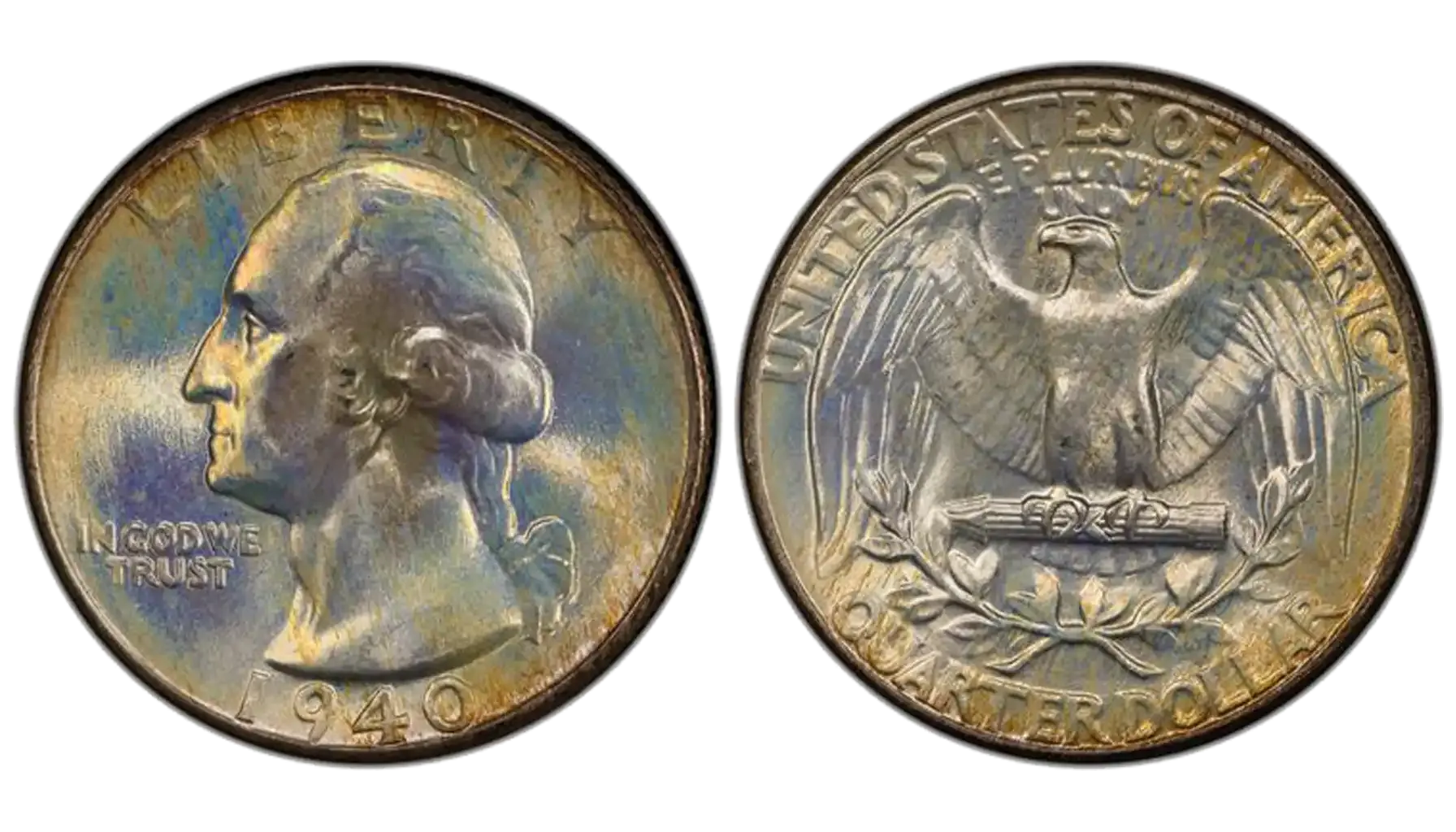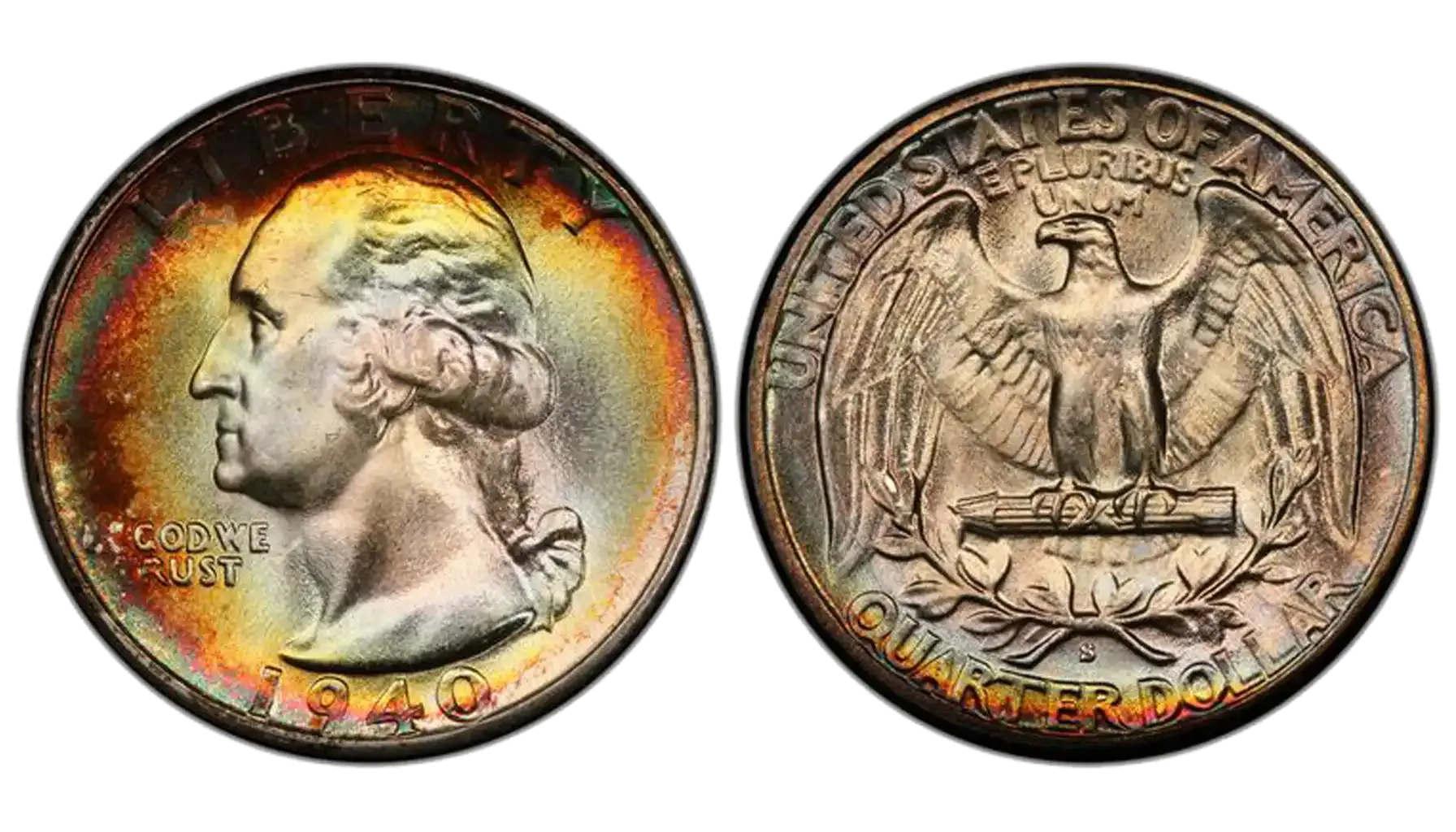Contents:
Minted from 1932 (with a single-year break in 1933) to 1998, the quarter's design, featuring George Washington on the obverse, has been a constant presence in our wallets and pocket change. But for collectors, certain years stand out, and 1940 is definitely one of them.
We're talking about potentially thousands of dollars for the right error on the right coin. And to find that coin, use а reliable coin identifier app.
This guide will walk you through everything you need to know about the 1940 D Washington Quarter, including its history, silver content, varieties, errors, and of course, its value.

Quarter's Production
It's 1940. Europe is already embroiled in World War II, and the United States is on the cusp of entering the conflict. Despite the looming global crisis, the US Mint was diligently producing Washington Quarters at three different facilities:
Philadelphia
Denver
San Francisco
The design itself, created by sculptor John Flanagan, is a classic. The obverse features a dignified portrait of George Washington, while the reverse depicts a majestic bald eagle with outstretched wings.
Where is the mint mark on a 1940 quarter?
To find the mint mark, look on the reverse of the coin, just below the eagle.
Each mint produced a different quantity of quarters in 1940, and these mintages directly impact a coin's rarity and, therefore, its value today. The Philadelphia Mint, which didn't use a mint mark, struck the largest number of quarters. Denver ("D" mint mark) and San Francisco ("S" mint mark) produced fewer coins. As we'll see later, that plays a big role in determining how much was a quarter worth in 1940.

1940 Quarter No Mint Mark | Common, but still worth more than 25 cents due to its silver content. |
1940 D Quarter Value | Generally more valuable than the Philadelphia version, especially in higher grades. |
1940 S Quarter Value | Often the most valuable of the three, particularly in uncirculated condition. |
To get a sense of what is a 1940 quarter worth based on the mint mark, check reputable coin value guide-books.
Silver Content
First, the 1940 US quarter value is tied to its composition. These quarters were struck from 90% silver, giving them an inherent worth that fluctuates with the silver market. Secondly, the 1940 Washington quarter value can rise if the coin has a rare error.
The price of silver fluctuates on the market, and the 1940 quarter silver value is directly tied to this fluctuation.
Is a 1940 quarter pure silver? No, it’s a mix. But the high silver content makes it desirable.
So, how much is a 1940 silver quarter worth? To figure this out, you need to know the current spot price of silver. You can find this information easily online. Then, use a silver coin calculator to determine the melt value of the quarter. Silver prices and demand change. Check often. Knowing the 1940 quarter value no mint mark compared to other mints is important.
Errors
A 1940 quarter error can transform a common coin into a valuable rarity.

Doubled Die Obverse (DDO) | This occurs when the die used to strike the obverse (Washington's portrait) has a doubled image. Look closely at the lettering and the details of Washington's face. If they appear to be doubled or blurred, you might have a DDO. |
Off-Center Strike | This happens when the coin wasn't properly centered during the striking process, resulting in a portion of the design being missing. |
Clipped Planchet | A clipped planchet occurs when the metal blank (planchet) that the coin is struck on has a portion missing, resulting in a crescent-shaped or straight edge on the finished coin. |
Die Cracks | Small cracks in the die can leave raised lines on the surface of the coin |
The presence of an error significantly impacts the value of a 1940 quarter. A doubled die obverse, for example, can be worth hundreds or even thousands of dollars, depending on the severity of the doubling and the condition of the coin. To determine the value 1940 quarter that is a true error, you will want to get your coin professionally graded to confirm.
So, how do you determine how much is 1940 quarter worth overall? It's a combination of factors:
Mint mark
Condition
Silver content
Presence of any errors
A common, circulated 1940 quarter might only be worth its silver melt value, plus a small premium. But a rare variety in uncirculated condition, or a coin with a significant error, can command a much higher price.
How Much Is a 1940 Quarter Worth Today?
So, is a 1940 quarter worth anything? Yes. At a minimum, it's worth its silver content. But it could be worth much more if it's in good condition or has an error.

Type/Condition | Worn | Fine | Extremely fine | Uncirculated |
From Philadelphia | $3-$5 | $6-$8 | $10-$15 | $20-$40 |
From Denver | $4-$7 | $8-$12 | $15-$25 | $30-$60 |
From San Francisco | $5-$10 | $10-$18 | $20-$30 | $40-$80 |
With errors | $50+ | $75+ | $90+ | $100-$120+ |
Determining Condition and Value
Poor/Heavily Worn | Basically, these coins are beat up. They're heavily worn, with very little detail remaining. You can barely make out the design, and there's probably a lot of scratching and damage. In this condition, the coin is usually worth its silver melt value, plus maybe a small premium. |
Fair/About Good | The design is visible, but heavily worn. Key details are mostly gone. There's still a lot of wear and tear. |
Good | Some details are visible, but there's significant wear overall. The lettering might be worn down in places. |
Very Good | More detail is visible, but there's still noticeable wear. Key features are still discernible. |
Fine | Moderate wear overall, but most of the details are still clear. The lettering is sharp, and the major design elements are well-defined. At this point, the coin starts to have a collector premium in addition to its silver value. |
Very Fine | Light to moderate wear. All the major details are clear, with good sharpness. Some of the finer details might be slightly worn, but overall, it's a nice-looking coin. |
Extremely Fine | Very light wear, mostly on the high points of the design. Most of the original detail is still present. |
About Uncirculated | Almost no wear. There might be some slight friction on the high points, but the coin is essentially uncirculated. |
Uncirculated | These coins are in mint condition. They have never been circulated and have no wear. The higher the grade within the uncirculated range (MS65, MS67, etc.), the more valuable the coin. |
How to Assess:
Handle the coin by its edges to avoid adding any new fingerprints or scratches. Examine the coin under good lighting. A magnifying glass can be helpful.
The highest points of the design are where wear will first appear. On a Washington Quarter, these include Washington's cheekbone, hairline, and the eagle's breast.
How much detail is still visible? Are the lettering and design elements sharp and clear, or are they worn down and blurry?
Are there any major scratches, dents, or other damage? This will significantly lower the value.
Online tools like PCGS are invaluable. They provide photos of coins in different grades, allowing you to compare your coin and get a sense of its condition.
Value = Condition + Mint Mark + Silver + (Maybe Errors)
Condition to Current Price
Once you've determined the condition, you can start to get a sense of its 1940 quarter value today.
Online Value Guides | Websites like PCGS (Professional Coin Grading Service) and NGC (Numismatic Guaranty Corporation) have online value guides that provide estimated prices for coins in different grades. These guides are based on recent auction results and market data. |
Auction Results | Check eBay's completed listings to see what similar coins have actually sold for recently. This can give you a more realistic sense of the market value. |
Coin Dealers | If you're unsure, take your coin to a reputable coin dealer for an appraisal. They can assess the condition and provide an estimate of its value. However, be aware that they will likely offer you less than the coin's retail value, as they need to make a profit. |



